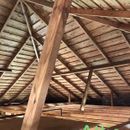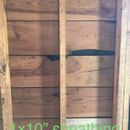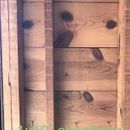Insulation in an old home
a) Location: Oklahoma City.
Climate zone: 3A.
Interior studs size: 1 1/2″ x 3 1/2″ (actual) spaced 16″ OC.
Roof rafters size: 1 1/2″ x 3 1/2″ (actual) spaced 24″ OC.
Home: 2 stories with 50/50 crawlspace and basement. The exterior is a single wythe of brick (non-structural), ½” to 1” gap (between brick and sheathing), tar paper and 1×10” (3/4” x 9 ¾” actual) of plank, horizontal sheathing.
Background: Currently all interior plaster/lath and drywall have been removed so all the interior framing is exposed. There was no insulation in the walls except for fiberglass batts in the kitchen which was renovated sometime in the 80s or 90’s. The fiber glass batts were dirty from air infiltration. The attic is an unconditioned space. The HVAC for the 2nd floor is installed in the attic. The attic insulation prior to plaster+lath/drywall was around R18 and was just your normal cellulose sprayed on the attic floor.
Question 1: Should I insulate the wall cavities with 2″ of CC spray foam or 3 1/2″ of mineral wool?
CC pros: Air sealing. My house has a lot of air infiltration that the CC would seal.
CC cons: The cons are it’s expensive, it can be difficult to find a good contractor and there are many very smart people with different opinions on CC that are swaying me away from CC like the article “Installing Closed-Cell Spray Foam Between Studs is a Waste.” OC spray foam is an option, but I have had contractors who specialize in old homes tell me to stay away from OC spray foam because it soaks water if there is a leak.
Mineral wool pros: Can install it myself, is cheaper overall and there is no chance of creating a toxic, inhabitable home like spray foam (though it’s rare).
Mineral wool cons: No air sealing. Though, I have heard of spray on products like Eco-seal, but I do not know if it would work for my home.
Question 2: How to convert the attic to a conditioned space with 2×4″ rafters ( 1/2″ x 3 1/2″ actual) spaced 24″ OC?
My idea is to fur out the rafters by installing 2x6s directly to the existing rafters (using OSB/plywood gusset plates to attach them to each other). This would give me about 9″ of space to add insulation. I don’t want to do OC spray foam (per Martins presentation “Why Are Attics Insulated With Open-Cell Spray Foam So Damp?”). I could do CC spray foam, but the extra weight would make me want to check with a structural engineer first. The easiest, to me, and most cost-effective solution would be to add mineral wool R23, 5.5″ batt + R15, 3.5″ batt. This would get me to my code minimum of R38 for my climate zone. Is this feasible?
GBA Detail Library
A collection of one thousand construction details organized by climate and house part














Replies
Spray foam should be a last resort, not only is it expensive and have a large environmental footprint but if done wrong it is near impossible to remediate.
I would search for somebody that does dense packing. Dense packed cellulose or fiberglass is not quite air tight but close enough in zone 3.
Your idea of furring down the rafters is a good one. Since in your climate you can do an unvented ceiling with fluffy insulation, I would also dense pack there as well and add a code min diffusion vent. Make sure to seal up the soffits and add a code min supply vent to the attic space.
Also please get rid of the fuel burner in the attic. In such warm climate, a high efficiency heat pump will easily heat the place and cost much less to run during the cooling season.
I researched and looked into dense packed cellulose, but I have the same fears with it as I do with open-cell spray foam. Namely, the impacts of water intrusion. If I understand if correctly, open-cell will absorb water same as the dense pack cellulose which, with the cellulose, will cause it to loose substantial R value.
I will look into dense packed cellulose/fiberglass between the rafters if I do fur them out. Thanks for the suggestion. Also, what is a diffusion vent?
Removing the fuel burner and installing a heat pump is the plan as of now. It's on it's last legs anyway and, like you stated, the heat pump should cost less to run. Plus, there are a ton of rebates right now for switching to a heat pump.
Usual issue with older homes is the lack of WRB and window flashing details. You have a WRB already so that is a good start, flashing details you can take care of when replacing windows. Once bulk water issues are dealt with, your wall is pretty much a standard wall so you can insulate with fluffy insulation. If you want a bit of belt and suspenders approach, you can staple some house wrap into the stud bays. This is fussy work, so only worth it if your tar paper is in bad shape.
If bulk water makes it into your walls, doesn't matter what your insulation is, you have bigger problems than a bit of R value loss.
Diffusion port info:
https://buildingscience.com/documents/guides-and-manuals/gm-2101-guide-building-conditioned-unvented-attics-and-unconditioned
Before you insulate you need to air seal your building, or your insulation will be useless as all the conditioned air is free to escape your home bypassing the insulation.
I general do not recommend spray foam but your walls are the exception as it is almost the only option to air seal your skip sheeting. Note when you air seal and insulate your old walls you are stopping all the heat that was drying your wall and all the air movement that carried away the excess moisture. In short, the original window & door flashing was likely poorly installed and that worked because the lack of insulation allowed the water that got in the walls to evaporate and the air movement carried the moisture away long before things got moldy and started rotting. If you are going to bring your insulation up to modern standards you must also bring the flashing up to the same standard or things could get ugly.
Before you jump on the over hyped conditioned attic band wagon. Do the math the saving are marginal at bests and sometimes nonexistent. Conditioning the attic means you must apply the insulation to the roof deck that look to my eye to be 30% larger than your attic floor. Conditioning the attic all but forces you to choose spray foam insulation that will likely cost five times as much for each R of insulation. Given the larger area and the higher costs per R most people run out of budget long before reaching the code minimum R value. Consider undoing the poor choice of putting the HVAC in the attic with a mini split or moving the equipment below the ceiling.
Walta
I definitely agree about the importance of air sealing and that is where the mineral wool falls short. I have thought of doing flash and batt which would be cheaper vs only CC spray foam. I also do plan on removing each of my windows to refurbish them and while I am doing that to properly flash/seal the openings.
As for the attic, using mini splits would be ideal but cost makes it prohibitive.